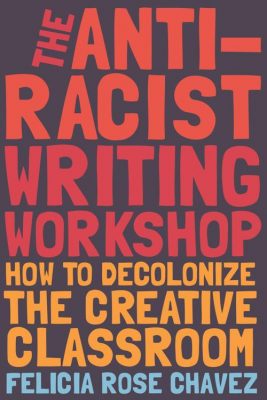Getting at the Heart of Antiracist Work in Chavez’s The Antiracist Writing Workshop
Chavez, Felicia Rose. The Antiracist Writing Workshop: How to Decolonize the Creative Classroom. Haymarket Books, 2021.
 There are a lot of texts out there about antiracist pedagogies and not a lot of time for the average instructor to read them and distill their contents. It’s easy to become overwhelmed, but luckily we’re here to help! In this post, we spotlight a new publication which focuses on implementing antiracist strategies in the classroom, Felicia Rose Chavez’s The Antiracist Writing Workshop: How to Decolonize the Creative Classroom.
There are a lot of texts out there about antiracist pedagogies and not a lot of time for the average instructor to read them and distill their contents. It’s easy to become overwhelmed, but luckily we’re here to help! In this post, we spotlight a new publication which focuses on implementing antiracist strategies in the classroom, Felicia Rose Chavez’s The Antiracist Writing Workshop: How to Decolonize the Creative Classroom.
Don’t let the title fool you — even if you don’t teach creative writing workshops, many of her suggestions can be tailored for first-year writing and literature courses. Part memoir, part rebellion against the white supremacist model of the creative writing workshop, Chavez’s slim volume offers suggestions for restructuring our teaching that dive deeply into not just how we respond to student work, but how we respond to students as people.
We’re particularly interested in how The Antiracist Writing Workshop can help guide us in choosing texts for our courses. A large part of Chavez’s book focuses on what she refers to as “Completing the Canon.” Though Chavez is specifically speaking to creative writing workshops here — pushing back on the imperative that students “read the masters” — many of her insights are applicable to the first-year writing classroom as well. Chavez encourages instructors to make choices that “promote justice, dignity, and self-love” when designing their reading lists. She suggests that:
Workshop leaders supplement participants’ own writing with a living archive of scanned print material, sourced pdfs, and multimedia art by young people, people of color, women, queer, differently abled, and gender-nonconforming artists. Accessible online, this living archive exposes participants to POC-friendly publishing platforms, multimedia art, and experimental genres. Most crucially, it allows for conversations with the authors themselves, contextualizing the texts within specific lived experiences. The ultimate goal is to invest in our collective integrity by renouncing white universality. Together, we can complete the canon and create a new normal (97).
Chavez offers an extensive (and growing) list of works to help enrich ECE course materials in this Google doc from her website, The Antiracist Writing Workshop.
Additionally, Chavez provides the following questions for instructors who are assessing their courses (45-46):
- For whom do you design your curriculum? In other words, who is your ideal, imagined student? What assumptions do you make about their background?
- What norms and values inform your curriculum choices?
- Do you articulate your own positionality when lecturing? Why or why not?
- Does your curriculum reflect its geographic location, including the subjugated histories, cultures, and languages?
- How does your teaching legitimate the experiences and cultures of students of color?
- How does your teaching affirm the agency of students of color?
- How does your curriculum require white students to acquire the intellectual and cultural resources to function effectively in a plural society?
- How do you build a community in your classroom where students learn actively from each other and draw on their own knowledge sources?
- What can you do to make your assessment criteria show what all students are capable of, drawing on their strengths and promoting their agency and creativity?
- Now ask yourself, am I read to prepare my headspace for change?
Answering these questions can feel humbling, but in a healthy way. They force us to reckon with the conscious and unconscious choices we make when we construct our syllabi and run our classroom, asking us who we are unintentionally excluding through our practice. Chavez’s work is illuminating, inspiring, and concise. At 180 pages (minus the appendices and notes), it’s something that instructors can read relatively quickly, dog-ear, and return to again. We suggest you take a look!
See Scott Campbell’s Part Two of this conversation here.